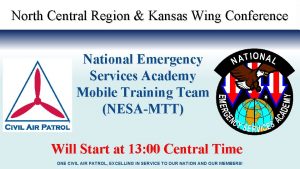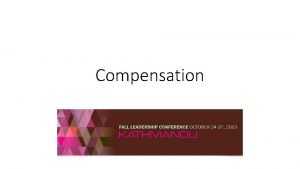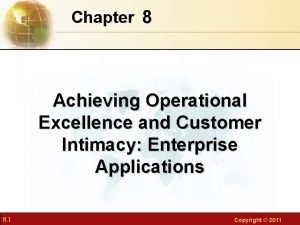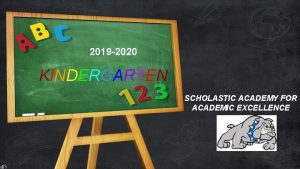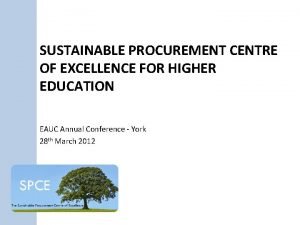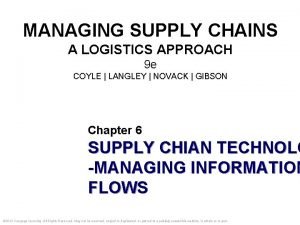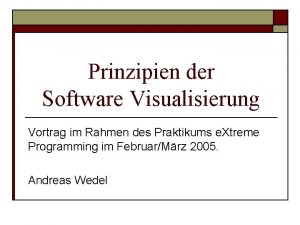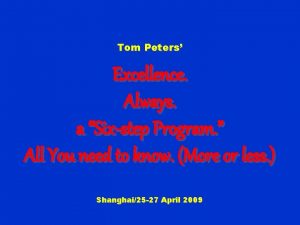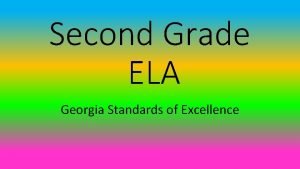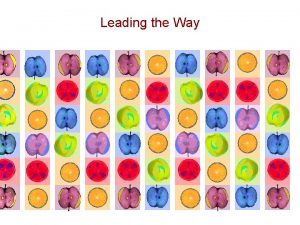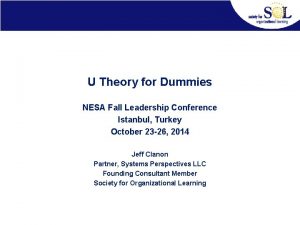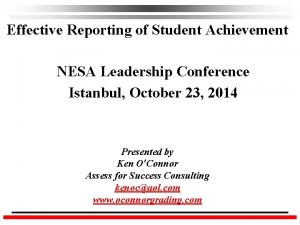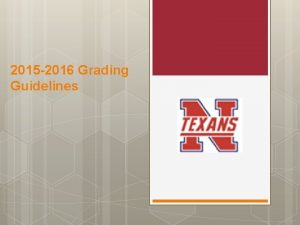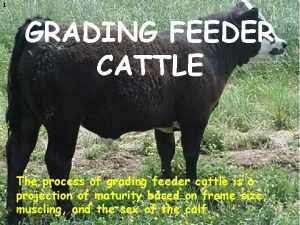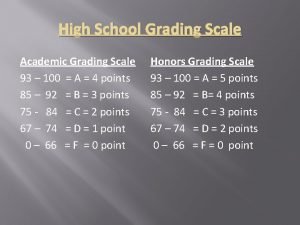Leading the Way to Grading Excellence NESA Leadership












































































- Slides: 76

Leading the Way to Grading Excellence NESA Leadership Conference Istanbul, October 24, 2014 Presented by Ken O’Connor Assess for Success Consulting kenoc@aol. com www. oconnorgrading. com 1 © Ken O’Connor, 2014

“Terms (are) frequently used interchangeably, although they (should) have distinct meanings. ” Mc. Tighe, J. , and Ferrara, S. , “Assessing Learning in the Classroom”, Journal of Quality Learning, December 1995, 11 2 © Ken O’Connor, 2014

What Do These Terms Mean? MARK(S)/SCORE(S) (marking/scoring) the number (or letter) "score" given to any student test or performance GRADE(S) (grading) A the number (or letter) reported at the B end of a period of time as a summary C D statement of student performance F 91 78 64 57 42 7/ 4 10 3 2 1 4 3 2 1 E G S N 3 © Ken O’Connor, 2014

“In a perfect world there would be no grades – at least, not as we know them now. ” Brookhart, S. Grading. Pearson Merrill, Upper Saddle River, NJ. 2009. 2 4 © Ken O’Connor, 2014

5 © Ken O’Connor, 2014

What is better is standards-based grading. SBG is grading that accurately portrays student proficiency/mastery. Grades are based on • standards not assessment methods, • levels of proficiency not points, and they are • not contaminated by non-achievement 6 factors. © Ken O’Connor, 2014

Why Standards-Based Grading and Reporting? 1. Mandate 2. Supports learning 3. Improves communication 4. Consistency/Fairness 5. Traditional grades are broken. 7 © Ken O’Connor, 2014

8 © Ken O’Connor, 2014

Principals/School Leaders - principals can and do have huge impact on how schools operate and on the quality of teaching and learning; - principals must provide informed leadership to promote and ensure effective communication of learning, primarily through grades and report cards; - must build shared understanding of purpose, procedures, policies, principles, and practices (professional judgment, motivation and fairness). 9 © Ken O’Connor, 2014

Garnet_hillman Q 2 Describe traits of successful school leaders & administrative teams in SBL/SBG cultures. #sblchat 10: 14 AM - 9 Oct 2014 10 © Ken O’Connor, 2014

@CVULearns A 2 Admin must be knowledgeable about real SB They can't just know theories, they need to get involved in planning and classes. #sblchat 9 Oct 2014 11 © Ken O’Connor, 2014

Brian Durst RESP 3 CTthe. GAME A 2 Successful SBL school leaders must be learners. They are supportive, persistent, & poised to handle resistance. Act w purpose sblchat 10: 16 AM - 9 Oct 2014 12 © Ken O’Connor, 2014

Ms. Woodcock @mswoodcockmath A 2 Supportive of the learning process, comfortable with explaining the grading shift to parents, other concerned parties #sblchat 9 Oct 2014 13 © Ken O’Connor, 2014

Brian G Seguin_B A 2: Successful leaders in a SBL/SBG environment model expectations and collaborate/reflect with staff routinely on the process. sblchat 10: 20 AM - 9 Oct 2014 14 © Ken O’Connor, 2014

Randy Squier rsquiercacsd A 2 sbl leaders allow time to meet standards for Ts and Ss. Make it safe to fail and try again. sblchat 10: 18 AM - 9 Oct 2014 15 © Ken O’Connor, 2014

Procedures - what schools require teachers to do; - should be public, published; - in the past often limited or non-existent; - now often developed by committee or task force; - should be derived from policy and make mission statement ‘live. ’ 16 © Ken O’Connor, 2014

Purpose • Communicate the achievement status of students to parents, (students), and others. • Provide information that students can use for self-evaluation. • Select, identify, or group students for certain educational paths or programs. • Provide incentives to learn. • Evaluate the effectiveness of instructional programs Guskey, Thomas R. (Editor), Communicating Student Learning: The 1996 ASCD Yearbook, ASCD, Alexandria, VA, 1996, 17 17 © Ken O’Connor, 2014

“the primary purpose of. . . grades. . . (is) to communicate student achievement to students, parents, school administrators, postsecondary institutions and employers. ” Bailey, J. and Mc. Tighe, J. , “Reporting Achievement at the Secondary School Level: What and How? ”, in Thomas R. Guskey, (Ed. ) Communicating Student Learning: ASCD Yearbook 1996, ASCD, Alexandria, VA, 1996, 120 18 © Ken O’Connor, 2014

Policy - broad statements of general intent; - policy sets out the general direction for what the school/Board seeks to accomplish. - The director is responsible for the implementation of policy through administrative policies and procedures. - policy has legal or quasi-legal status. 19 © Ken O’Connor, 2014

xxxxxxxxxxxxx 20 © Ken O’Connor, 2014

Wellesley is adopting a new shadow-grading policy for first year students. Wellesley has instituted a shadow-grading policy beginning with students entering in the fall of 2014. These students will receive pass/no pass grades in all of their courses for the first semester of their first year. The students themselves will be given a report of the letter grades that they would have received - "shadow grades" – but these will not appear on their official transcripts and will not be released outside the College. http: //www. wellesley. edu/registrar/grading_policy/shadow_ grading_policy Accessed on October 11, 2014 21 © Ken O’Connor, 2014

MIT Freshman Grading In the first semester and the January Independent Activities Period (IAP) freshmen are graded on a Pass or No Record basis in all subjects they take, where P (passing) means C- or better performance. Freshmen earn no credit for subjects with D and F grades. In the second semester, freshmen are graded on an A, B, C or No Record basis. They continue to earn no credit for subjects with D and F grades. http: //web. mit. edu/registrar/reg/grades/freshmangrading. html Accessed on October 11, 2014 22 © Ken O’Connor, 2014

Principles - the set of values that orient and rule the conduct of an individual or organization; - often expressed in mission/vision statements. - “The International School. . . is a community that is committed to excellence. We inspire students with a challenging, international education, based on an American curriculum, in a nurturing learning environment that promotes responsibility and respect. We aim to develop socially engaged, self-motivated, creative, compassionate individuals who will be a force for positive change in their communities and the world. ” Source: an international school in Asia. 23 © Ken O’Connor, 2014

Freshman grading is designed to ease the transition from high school by giving students time to adjust to factors like increased workloads and variations in academic preparation. A, B, and C grades are used during the second semester so that freshmen can begin the progression to regular A-F grading in the sophomore year. http: //web. mit. edu/registrar/reg/grades/freshmangrading. html Accessed on October 11, 2014 24 © Ken O’Connor, 2014

This policy provides first-year students with the opportunity to learn about the standards for academic achievement at Wellesley and to assess the quality of their work in relation to these standards. It further enables them to use their first semester to refocus attention from grades to intellectual engagement and inspiration and to learn how to grow as a learner in college. http: //www. wellesley. edu/registrar/grading_policy/shadow_grading _policy Accessed on October 11, 2014 25 © Ken O’Connor, 2014

Assessment in the MYP aims to: • support and encourage student learning by providing feedback on the learning process • inform, enhance and improve the teaching process • provide opportunity for students to exhibit transfer of skills across disciplines, such as in the personal project and interdisciplinary unit assessments • promote positive student attitudes towards learning • promote a deep understanding of subject content by supporting students in their inquiries set in real-world contexts • promote the development of critical- and creative-thinking skills • reflect the international-mindedness of the programme by allowing assessments to be set in a variety of cultural and linguistic contexts • support the holistic nature of the programme by including in its model principles that take account of the development of the whole student. 26 MYP; Principles into Practice. May 2014. 78 © Ken O’Connor, 2014

“. . . the primary purpose of classroom assessment is to inform teaching and improve learning, not to sort and select students or to justify a grade. ” Mc. Tighe, J. and Ferrara, S. “Performance-Based Assessment in the Classroom”, Pennsylvania ASCD 27 © Ken O’Connor, 2014

Practices #1: PROFESSIONAL JUDGMENT Traditional view Objective good! Subjective bad!! Strive to be objective! 28 © Ken O’Connor, 2014

Practices #1: PROFESSIONAL JUDGMENT “All scoring by human judges, including assigning points and taking them off math homework is subjective. The question is not whether it is subjective, but whether it is defensible and credible. The AP and IB programs (are) credible and defensible, yet subjective. I wish we could stop using that word as a pejorative! So-called objective scoring is still subjective test writing. ” Grant Wiggins, January 19, 2000 answering a question on chatserver. ascd. org 29 © Ken O’Connor, 2014

Practices #1: OBJECTIVITY AND PROFESSIONAL JUDGMENT “I define professional judgment as “decisions made by educators, in light of experience, and with reference to shared public standards and established policies and guidelines. ” Cooper, D. 2011. Redefining Fair. Solution Tree, Bloomington, IN. 13 30 © Ken O’Connor, 2014

Practices #2: MOTIVATION “Drive” by Daniel Pink Motivation 1. 0 - the ancient drive to survive Motivation 2. 0 - rewarding good work with pay, benefits and promotions - centres on "Type X behaviour” where people are motivated mostly by external rewards. 31 © Ken O’Connor, 2014

Practices #2: MOTIVATION Pink believes it is time for a "full scale upgrade" to Motivation 3. 0 - intrinsic rewards that play to the intrinsic satisfaction of the activity. Motivation 3. 0 is based on what Pink calls "Type I behavior, " where the main motivators are the freedom to do what you want, the opportunity to take a challenge and fulfillment by the purpose of the undertaking. Source- review by Richard Eisenberg in USA Today, January 25, 2010 32 © Ken O’Connor, 2014

Practices #2: MOTIVATION “All kids start out as curious self-directed Type I’s. But many of them end up as disengaged, compliant Type X’s. . If we want to equip young people for the new world of work - and more important, if we want them to lead satisfying lives - we need to break Motivation 2. 0’s grip on education and parenting. . Unfortunately, as with business, there is a mismatch between what science knows and what schools do. . . We’re bribing students into compliance instead of challenging them into engagement. ” Daniel Pink, 2009, Drive, Riverhead Books, New York, 174 33 © Ken O’Connor, 2014

Practices #2: MOTIVATION According to Pink the keys to Motivation 3. 0 are Autonomy Mastery Purpose 34 © Ken O’Connor, 2014

Practices #3: FAIRNESS What does FAIR mean ? “All students are given an equal opportunity to demonstrate what they know and can do as part of the assessment process. Adaptations to assessment materials and procedures are available for students including but not restricted to students with learning disabilities, to allow them to demonstrate their knowledge and skills, provided that the adaptations do not jeopardize the integrity or content of the assessment. ” Adapted from Manitoba Education and Training at http: //www. edu. gov. mb. ca/metks 4/curricul/assess/aepolprod/purpos~2. html 35 © Ken O’Connor, 2014

Practicality - procedures and principles have to actually work in the classroom; - means that we have to follow the spirit of the agreed upon principles and the published procedures but sometimes have to adapt to make them ‘work’ at different grade levels and in different subjects. 36 © Ken O’Connor, 2014

GIVENS - quality assessment (Doing it Right) - student involvement (Using it Well) 37 © Ken O’Connor, 2014

SIX MUSTS - standards-based - no single subject grades - performance standards – levels of proficiency not % - achievement separated from behaviors - late, missing, academic dishonesty, attendance - summative only - no mark, comment only formative assessment - more recent emphasized - some, not all evidence - number crunching - no means, no zeros 38 © Ken O’Connor, 2014

For each Must Why? for you, school, students, parents Why not? 39 © Ken O’Connor, 2014

1. Base grades on, and provide grades for, the intended learning goals, which means very limited use of single subject grades. 40 © Ken O’Connor, 2014

Part of a Traditional Report Card English Mathematics Science Social Studies Phys Ed Music B C F A A D 41 © Ken O’Connor, 2014

“The principal limitation of any grading system that requires the teacher to assign one number or letter to represent. . . learning is that one symbol can convey only one meaning. . One symbol cannot do justice to the different degrees of learning a student acquires across all learning outcomes. ” Tombari, G. and Borich, M. Authentic Assessment in the Classroom, Prentice Hall, 1999, 213 42 © Ken O’Connor, 2014

43 © Ken O’Connor, 2014

44 © Ken O’Connor, 2014

2. Use performance standards with a limited number (2 -7) of clearly described levels which means no use of a percentage scale. 45 © Ken O’Connor, 2014

“Performance standards specify ‘how good is good enough. ’ They relate to issues of assessment that gauge the degree to which content standards have been attained. . They are indices of quality that specify how adept or competent a student demonstration should be. ” Kendall, J. , and R. Marzano, Content Knowledge: A Compendium of Standards and Benchmarks for K-12 Education, First Edition, Mc. REL, 1997, 16 -17 46 © Ken O’Connor, 2014

For classroom assessment Performance Standards = OVERALL descriptors of 2 - 7 levels which form the base for SUBJECT/ scoring tools (rubrics, etc) GRADE LEVEL/ TASK + SPECIFIC work samples (exemplars) + commentaries on the work samples Adapted from New Standards Sampler, National Center on Education and the Economy, 47 www. ncee. org © Ken O’Connor, 2014

Wow! Got it! Nearly there! Oh no! Oops! 48 © Ken O’Connor, 2014

MYP; Principles into Practice. May 2014. 93 49 © Ken O’Connor, 2014

Cut Scores out of 20 Difficult skills, concepts, assessment 7 15 6 13 5 11 4 9 3 7 2 5 1 Below 5 Easy skills, concepts assessment 19 17 15 13 11 9 Below 9 50 © Ken O’Connor, 2014

51 © Ken O’Connor, 2014

3. Limit the student attributes included in grades to Individual ACHIEVEMENT, which means no penalties and no bonuses. 52 © Ken O’Connor, 2014

O’Connor, K. How to Grade for Learning. Third Edition. Corwin. 2009, 40 53 © Ken O’Connor, 2014

Dealing with Late Work Meeting timelines is the expected behavior but when that are not meet then 1. Support not penalties 2. Behaviors/Learning Skills 3. Clarity/Communication 4. Consequences 54 © Ken O’Connor, 2014

Grades should not be inflated by the use of extra credit or bonus points but students should always be able to provide evidence that they are achieving at a higher level. It is not about the quantity of points, it is about what the evidence shows about the quality of achievement. 55 © Ken O’Connor, 2014

Academic dishonesty is a behavior which should have behavioral consequences which should be indicated in the school Code of Conduct. Assessment evidence needs to be accurate so we need untainted evidence, thus the assessment consequence is “DO IT AGAIN HONESTLY. ” 56 © Ken O’Connor, 2014

“No student’s grade should depend on the achievement (or behavior) of other students. ” Source: William Glasser 57 © Ken O’Connor, 2014

4. “Grade performance, learn from practice, ” which means ‘comment only, no mark’ formative assessment and homework has little or no place in grades. 58 © Ken O’Connor, 2014

“The ongoing interplay between assessment and instruction, so common in the arts and athletics, is also evident in classrooms using practices such as non-graded quizzes and practice tests, the writing process, formative performance tasks, review of drafts and peer response groups. The teachers in such classrooms recognize that ongoing assessments provide feedback that enhances instruction and guides student revision. ” Jay Mc. Tighe, “What Happens Between Assessments, ” Educational Leadership, Dec. ‘ 96 -Jan. ‘ 97, 11 59 © Ken O’Connor, 2014

• “Provide risk-free (that is, ungraded, formative assessment) opportunities. . . • Provide timely and specific feedback to students on their assessments - not just a letter or number grade. ” Almeida. L, in Reeves. D (Ed) Ahead of the Curve, Solution Tree, Bloomington, IN, 157 60 © Ken O’Connor, 2014

Sample Assessment Plan Formative Assessment for Unit 1 Summative Assessment for Unit 1 Source: O’Connor, K. A Repair Kit for Grading, Pearson ATI, 2011, 113 61 © Ken O’Connor, 2014

5. Grade in pencil, which means new evidence replaces old evidence and grades cannot be determined only numerically. 62 © Ken O’Connor, 2014

Fix #14 63 O’Connor, K. , A Repair Kit for Grading, Pearson ATI, 2011, 123 © Ken O’Connor, 2014

Conditions for “Second Chance” Assessment Always - evidence of “correctives” Optional - opportunity cost 64 © Ken O’Connor, 2014

6. Don’t accept mean teachers - “crunch” numbers carefully, if at all, which means no zeros, no percentages, and acknowledging that grading is primarily an exercise in professional judgment. 65 © Ken O’Connor, 2014

“Data should be used to INFORM not determine decisions” Management Consultant, The Hay Group, personal conversation, January 2002 66 © Ken O’Connor, 2014

First test Second test Third test Fourth test Fifth test Sixth test Source: Richard Brown, an Alberta high school teacher 67 © Ken O’Connor, 2014

Fix #11 Alberta Written Test for Driver’s Licence 6. 0/7. 0 (85%) required to pass First attempt 1. 00/7. 0 (14%) Second attempt 6. 0/7. 0 (85%) Mean 3. 5 Third attempt 6. 3 /7. 0 (90%) Mean 4. 4 Fourth attempt 6. 7/7. 0 (95%) Mean 5. 0 Fifth attempt 7. 0/7. 0 (100%) Mean 5. 4 Sixth attempt 7. 0/7. 0 (100%) Mean 5. 8 Seventh attempt 7. 0/7. 0 (100%) Mean 6. 0 Source: Richard Brown, Alberta high school teacher 68 © Ken O’Connor, 2014

The Effect of Zeros 5 pt scale 4 (A) 3 (B) 2 (C) 1 (D) 0 (F) 2 (C) 101 point scale 90 -100 11 95 95 80 -89 10 85 85 70 -79 10 75 75 60 -69 10 65 <60 0 50 64 (D) 74 (C) Source: O’Connor, K. A Repair Kit for Grading, Pearson ATI, 2011, 98 69 © Ken O’Connor, 2014

“The use of an I or “Incomplete” grade is an alternative to assigning zeros that is both educationally sound and potentially quite effective. ” Guskey, T. R. and Bailey, J. Developing Grading and Reporting Systems for Student Learning, Corwin Press, 2001, 144 70 © Ken O’Connor, 2014

The Hanover Research Council profiled a number of top-ranked and regional institutions regarding their attitudes on standards-based grading. For all types of colleges, high school course selection has become a more important criterion for admission for a number of reasons. According to the report, GPA relevance is debatable due to widely varying grading scales and weighting practices among high schools. 71 Source: Hanover Research Council conducted a study for QCSD © Ken O’Connor, 2014

Colleges and universities look for some of the following types of information from high schools to help them navigate discrepancies: Background from the guidance department on the high school's students, grading scales, and academic rigor. Evaluation of a high school’s past students and their success at the institution. GPA recalculation based on specific core courses. GPA recalculation to exclude or include weight for honors, Advanced Placement, or International Baccalaureate courses. Required or recommended interview with an admissions officer, in person or via the Internet. Source: Hanover Research Council conducted study forwith QCSD 72 Visits to high schools, where officers can ameet guidance counseling staff © Ken O’Connor, 2014

Conclusion: The Hanover Research Council report states that “Generally, admissions offices treat all grades as welcome indicators of high school performance while implicitly acknowledging that every school has a unique perspective, student body, and system. ” None of the college admissions offices contacted expressed a concern or a negative view of a transcript based on standards-based grading. Source: Hanover Research Council conducted a study for QCSD 73 © Ken O’Connor, 2014

What I would really like to see K-12 * No subject grades and no GPA except 11/12 * No % - limited number of proficiency levels for scoring and grading * No class rank * No more than 3 achievement report cards per year, i. e. , high quality SB EF * Parent portals - summarizing function turned off for at least 6 weeks * Collaboration required across grade level, courses leading to ‘one pagers’ * Assessment plans that clearly identify ‘body of evidence’ for which each student is responsible 74 © Ken O’Connor, 2014

“If you wanted to make just one change that would immediately reduce student failure rates, then the most effective place to start would be challenging prevailing grading practices” Reeves, D. Leading to change: Effective grading practices. Educational Leadership, 65(5), 2008, 85 75 © Ken O’Connor, 2014

“Assigning fair and meaningful grades to students will continue to challenge educators at every level. The process requires thoughtful and informed professional judgment, an abiding concern for what best serves the interests of students and their families, and careful examination of the tasks students are asked to complete and the questions they are asked to answer to demonstrate their learning. only when such examination and reasoned judgment become a regular part of the grading process can we make accurate and valid decisions about the quality of students' performance. ” Guskey, T. R. 2013. “The Case Against Percentage Grades. ” Educational Leadership. September. 72 76 © Ken O’Connor, 2014
 Nesa u
Nesa u Cap nesa
Cap nesa Nesa
Nesa Bobbin leading and flyer leading
Bobbin leading and flyer leading Transactional leadership
Transactional leadership Adaptive leadership characteristics
Adaptive leadership characteristics Capable but cautious performer
Capable but cautious performer Our leadership way nhs
Our leadership way nhs One was a ship
One was a ship Frequency trig
Frequency trig Anova hypothesis examples
Anova hypothesis examples Walk this way talk this way
Walk this way talk this way Two way anova
Two way anova One way anova vs two way anova
One way anova vs two way anova What is threaded binary tree
What is threaded binary tree Conventional software engineering
Conventional software engineering Pertanyaan tentang anova
Pertanyaan tentang anova Perbedaan one way dan two way anova
Perbedaan one way dan two way anova Tư thế worm breton là gì
Tư thế worm breton là gì ưu thế lai là gì
ưu thế lai là gì Thẻ vin
Thẻ vin Tư thế ngồi viết
Tư thế ngồi viết Cái miệng bé xinh thế chỉ nói điều hay thôi
Cái miệng bé xinh thế chỉ nói điều hay thôi Các châu lục và đại dương trên thế giới
Các châu lục và đại dương trên thế giới Cách giải mật thư tọa độ
Cách giải mật thư tọa độ Bổ thể
Bổ thể Từ ngữ thể hiện lòng nhân hậu
Từ ngữ thể hiện lòng nhân hậu Tư thế ngồi viết
Tư thế ngồi viết Giọng cùng tên là
Giọng cùng tên là Thơ thất ngôn tứ tuyệt đường luật
Thơ thất ngôn tứ tuyệt đường luật Hát lên người ơi alleluia
Hát lên người ơi alleluia Sự nuôi và dạy con của hươu
Sự nuôi và dạy con của hươu Diễn thế sinh thái là
Diễn thế sinh thái là Vẽ hình chiếu vuông góc của vật thể sau
Vẽ hình chiếu vuông góc của vật thể sau Công thức tiính động năng
Công thức tiính động năng Làm thế nào để 102-1=99
Làm thế nào để 102-1=99 Tỉ lệ cơ thể trẻ em
Tỉ lệ cơ thể trẻ em Thế nào là mạng điện lắp đặt kiểu nổi
Thế nào là mạng điện lắp đặt kiểu nổi Lời thề hippocrates
Lời thề hippocrates Vẽ hình chiếu đứng bằng cạnh của vật thể
Vẽ hình chiếu đứng bằng cạnh của vật thể đại từ thay thế
đại từ thay thế Quá trình desamine hóa có thể tạo ra
Quá trình desamine hóa có thể tạo ra Các môn thể thao bắt đầu bằng tiếng bóng
Các môn thể thao bắt đầu bằng tiếng bóng Sự nuôi và dạy con của hổ
Sự nuôi và dạy con của hổ Hát kết hợp bộ gõ cơ thể
Hát kết hợp bộ gõ cơ thể Các loại đột biến cấu trúc nhiễm sắc thể
Các loại đột biến cấu trúc nhiễm sắc thể Biện pháp chống mỏi cơ
Biện pháp chống mỏi cơ Trời xanh đây là của chúng ta thể thơ
Trời xanh đây là của chúng ta thể thơ độ dài liên kết
độ dài liên kết Gấu đi như thế nào
Gấu đi như thế nào Thiếu nhi thế giới liên hoan
Thiếu nhi thế giới liên hoan Tia chieu sa te
Tia chieu sa te điện thế nghỉ
điện thế nghỉ Một số thể thơ truyền thống
Một số thể thơ truyền thống Thế nào là hệ số cao nhất
Thế nào là hệ số cao nhất Sơ đồ cơ thể người
Sơ đồ cơ thể người Ng-html
Ng-html Bảng số nguyên tố
Bảng số nguyên tố đặc điểm cơ thể của người tối cổ
đặc điểm cơ thể của người tối cổ Các châu lục và đại dương trên thế giới
Các châu lục và đại dương trên thế giới Operational excellence
Operational excellence Excellence through passion slogan
Excellence through passion slogan Scholastic academy
Scholastic academy Procurement centre of excellence
Procurement centre of excellence Six drivers of supply chain excellence
Six drivers of supply chain excellence Eden european destinations of excellence
Eden european destinations of excellence Icos center of excellence
Icos center of excellence Graphical excellence tufte
Graphical excellence tufte Excellence always
Excellence always Retail excellence definition
Retail excellence definition Equity and excellence: liberating the nhs
Equity and excellence: liberating the nhs Witsa global ict excellence awards
Witsa global ict excellence awards Simulation centre of excellence
Simulation centre of excellence Ibm center of excellence
Ibm center of excellence Safety centers of expertise
Safety centers of expertise Sovereign citizen starter pack
Sovereign citizen starter pack 2nd grade reading standards ga
2nd grade reading standards ga

